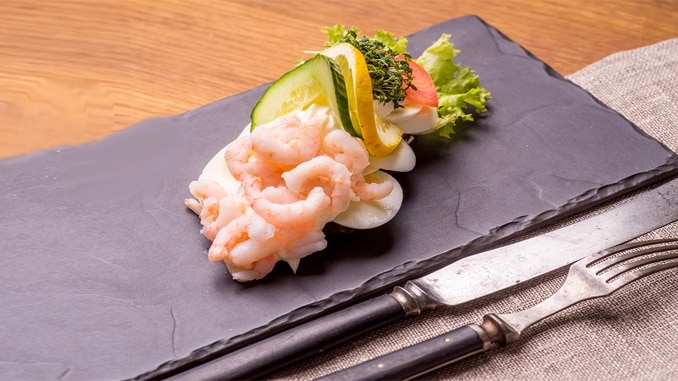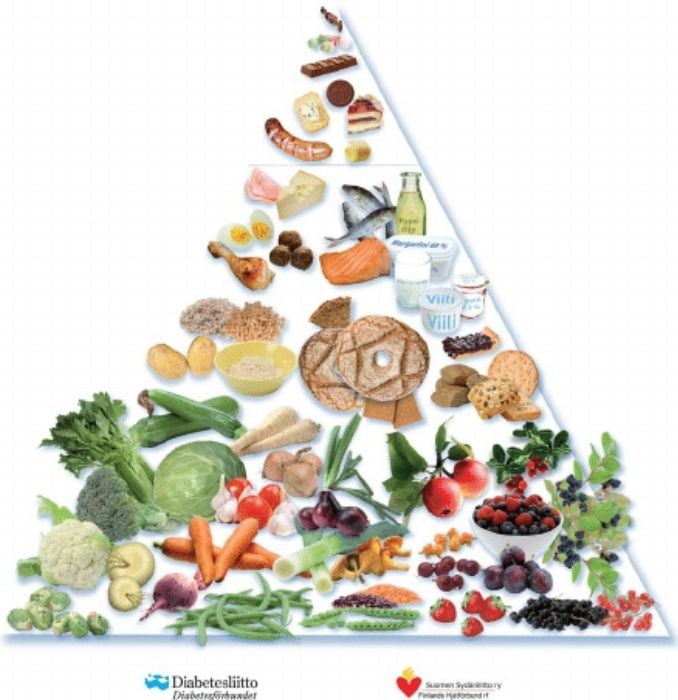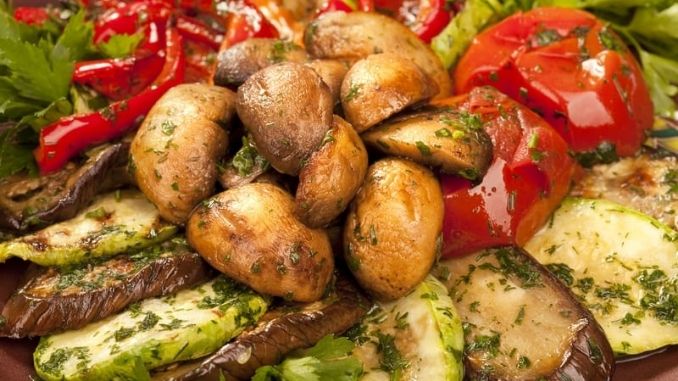
The Nordic diet has been making waves lately in the health community. Many are claiming the Nordic diet is the healthiest way to eat. As far as popular diets go, we’re impressed with the health benefits and overall nutritional sense of the Nordic diet.
What Is the Nordic Diet?
In 2004, a handful of the top chefs from Finland, Denmark, Sweden, Norway and Iceland got together in Copenhagen to develop a way of cooking and eating that was healthy and sustainable. The result was the Nordic diet.
In a nutshell, the Nordic diet is a plant-based, whole foods eating plan that was created in accordance with the Baltic Sea Diet Pyramid.
The Baltic Sea Diet Pyramid is a collaborative set of guidelines created by the Finnish Diabetes Association, the University of Eastern Finland and the Finnish Heart Association. Here’s an infographic of the pyramid, compliments of the Finnish:
As you can see, the Baltic Sea Diet Pyramid is heavy on vegetables and berries. It’s light on meat like beef and pork but recommends some fish, Icelandic skyr yogurt and unsaturated fat. Sweets are very limited, and packaged food is out of the question.
Fundamentals of the Nordic Diet
Trina Hahnemann, the author of the book, “The Nordic Diet: Using Local and Organic Food to Promote a Healthy Lifestyle,” says there are seven fundamentals of the Nordic diet. This is Hahnemann’s list of fundamentals:
- Eating balanced meals with an emphasis on whole grains and seasonal vegetables
- Doing home cooking with fresh ingredients, including homemade bread
- Eating less
- Eating fish at least twice a week
- Eating vegetarian meals twice a week
- Eating game, chicken or other meats only three times a week at most
- Taking the time to eat with friends and family on a daily basis
A. Balanced Meals
The Nordic diet promotes a balanced meal plan. At every meal, you’ll balance protein with fat and whole-grain carbohydrates. There are no missing food groups. You won’t have to give up fat or carbohydrates on the Nordic diet. Rather, your meals and snacks will be based on whole foods rich in nutrients.
B. Seasonal Produce
The Nordic diet is heavy on vegetables. On this meal plan, around 40 percent of your diet will be made up of vegetables. One of the best ways to get the required amount of dietary vegetables on this diet is to include vegetables in every meal and snack you eat. Have a half an avocado with your oatmeal in the morning or add chopped spinach to your scrambled eggs. Have carrot sticks and hummus as an afternoon snack. Fill your plate at least halfway with vegetables at dinnertime.
Certain fruits are acceptable on the Nordic diet as well. Berries, apples, pears, plums, and prunes are all allowable foods on the plan. Add whole fruits into your diet several times a day.
C. Home Cooking
It’s difficult to get quality nutritious foods at restaurants — particularly without added salt, sugar and unhealthy fats. You’re encouraged to cook and prepare your food at home. Hahnemann even recommends learning to bake your own whole-grain bread. (Finally, a diet that won’t require me to give up bread!)
Of course, this doesn’t mean you can never eat out when you’re on the diet. The best thing to order when you are eating away from home is a big salad loaded with vegetables. And if baking bread seems a bit too ambitious for you, look for an organic, 100 percent whole-grain bread made without sugar.
D. Eating Less
One principle that’s central to this diet is eating when you’re hungry and stopping when you feel your hunger has been satisfied. Stopping when you’re no longer hungry is much different than pushing away from the table when you’re full.
E. Eat Fish at Least Twice a Week
This diet recommends eating sustainable caught, fatty fish two to three times per week. The recommended fish include herring, salmon and mackerel. Fish helps provide protein, omega-3 fatty acids and other essential nutrients.
F. Eat Vegetarian Meals Twice a Week
Give your digestive system a break from meat and aim for two vegetarian meals per week. Try dishes like a stir-fry with organic cabbage, onions, snap peas, broccoli, and slivered almonds.
G. Limit Certain Meats to Three Times per Week
This diet allows you to enjoy poultry and other lean meats, but not every day. Ideally, those on the Nordic plan should eat meat sparingly and on the side, rather than as a main dish. Make sure you eat meat no more than three times a week.
H. Eat with Family and Friends Regularly
It can be challenging to get the entire family together around the table. Hahnemann says, “Make a conscious decision that home-cooked food and eating together is part of your everyday life and one thing you want to spend time doing.”
Live alone? Take some dinner over to another lone neighbor once a week. It’s almost certain that you’re not the only person who lives alone on your block or in your building. Get to know other people on your street and reach out to them. Your life will be enriched when you share it with another person in your community.
The Nordic diet isn’t just about eating healthily. It’s about enjoying your life and allowing food to bring you into the community with your friends and family.
Live Like the Nordic People
Hahnemann wrote about the people of the small Nordic country of Denmark in her book. She said that because of the high taxation on vehicle ownership, nearly everyone in Denmark rides a bike to work and on errands. Most children begin riding a bicycle to school by the age of 8 and continue throughout their education. Utility bicycles, designed to transport groceries and other items are also common in Denmark.
Nordic people are outside more and active. As a result, few of them struggle with obesity. In fact, according to ongoing, worldwide obesity research, the United States has nearly four times the rate of adult obesity than that of Norway.
Stay Away from Processed Foods and Sweetened Drinks
The Nordic diet advises against any type of processed food. The meal-in-a-box will not work on the Nordic diet. If you don’t have a private chef, you’ll find yourself spending more time in the kitchen while you’re on the diet.
Water, tea and coffee will be your main sources of hydration on the Nordic diet. Obviously, soda isn’t an option. Neither are juices and other sweetened drinks.
Nordic Diet Similar to Mediterranean Diet
If the Nordic diet sounds strangely familiar to you, it is likely because of its similarity to the Mediterranean diet. However, there are a couple of differences. The Mediterranean diet recommends a glass of red wine every night. On this diet, alcohol is allowed sparingly, if at all. Also, the Mediterranean diet advises cooking with olive oil. On the other hand, this diet relies on canola (rapeseed) oil for cooking.
Health Benefits of the Nordic Diet
Most people lose weight when using the Nordic diet. Other benefits include reduced cholesterol, lower blood sugar and a decreased risk of certain types of cancer.
A 2015 study in the American Journal of Clinical Nutrition found that following the Nordic diet “downregulates the expression of genes involved in inflammation.” This diet is excellent for people with chronic inflammation, arthritis and other painful conditions.
Another study, published in a journal called Nutrients in 2015, showed that adherence to the Nordic diet is associated with a lower risk of type 2 diabetes.
Is the Nordic Diet Similar to the Diet of the Vikings?
While it sounds particularly clever to title your blog post “The Nordic diet – Eat Like a Viking,” the Nordic diet is not all that similar to the diet of Erik the Red and his cohorts.
Vikings ate lots of meat, scurvy grass and whatever delicacies they could pillage from towns they would conquer. They also drank plenty of beer and another strong fermented juice beverage called bjorr. The Vikings may have been Nordic. But, they weren’t on the Nordic diet.
A Sample Meal Plan for the Nordic Dieter
You might be wondering what a day’s worth of food would look like if you were on the Nordic diet. Here’s a sample meal plan:
- Breakfast: Smoked salmon and red onion slices on top of whole-grain toast with plain, Icelandic skyr and capers
- Snack: Broccoli and hummus
- Lunch: Shredded cabbage salad with cucumbers and beets with a dressing made from canola oil, balsamic vinegar, salt and black pepper, and then topped with pumpkin seeds.
- Snack: A bowl full of berries, sliced bell peppers and an ounce of cheese
- Dinner: Pan-fried cauliflower steaks with roasted root vegetables on the side and a slice of whole grain bread with butter
Nordic Diet is a Healthy Option
Overall, we like the Nordic diet for its whole food, plant-based, sustainable vibe. It’s the kind of diet that offers more than just a way to eat but also a way to live. The health benefits of the Nordic diet and lifestyle are excellent. It may be something to consider if you’re looking for a new outlook on food and life.
For your guide to the best foods to heal your body, check out The Best Foods that Rapidly Slim & Heal in 7 Days, here!






